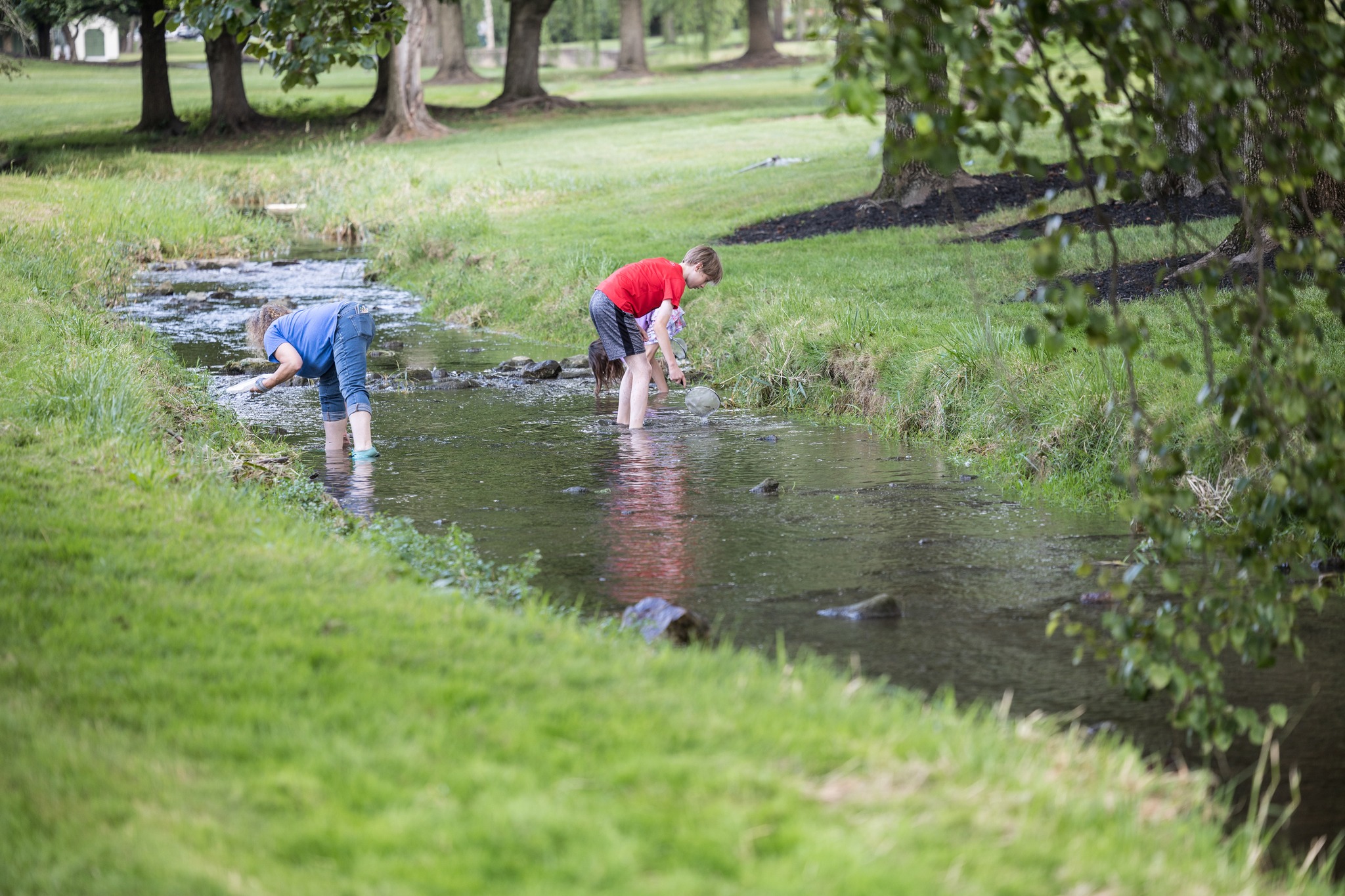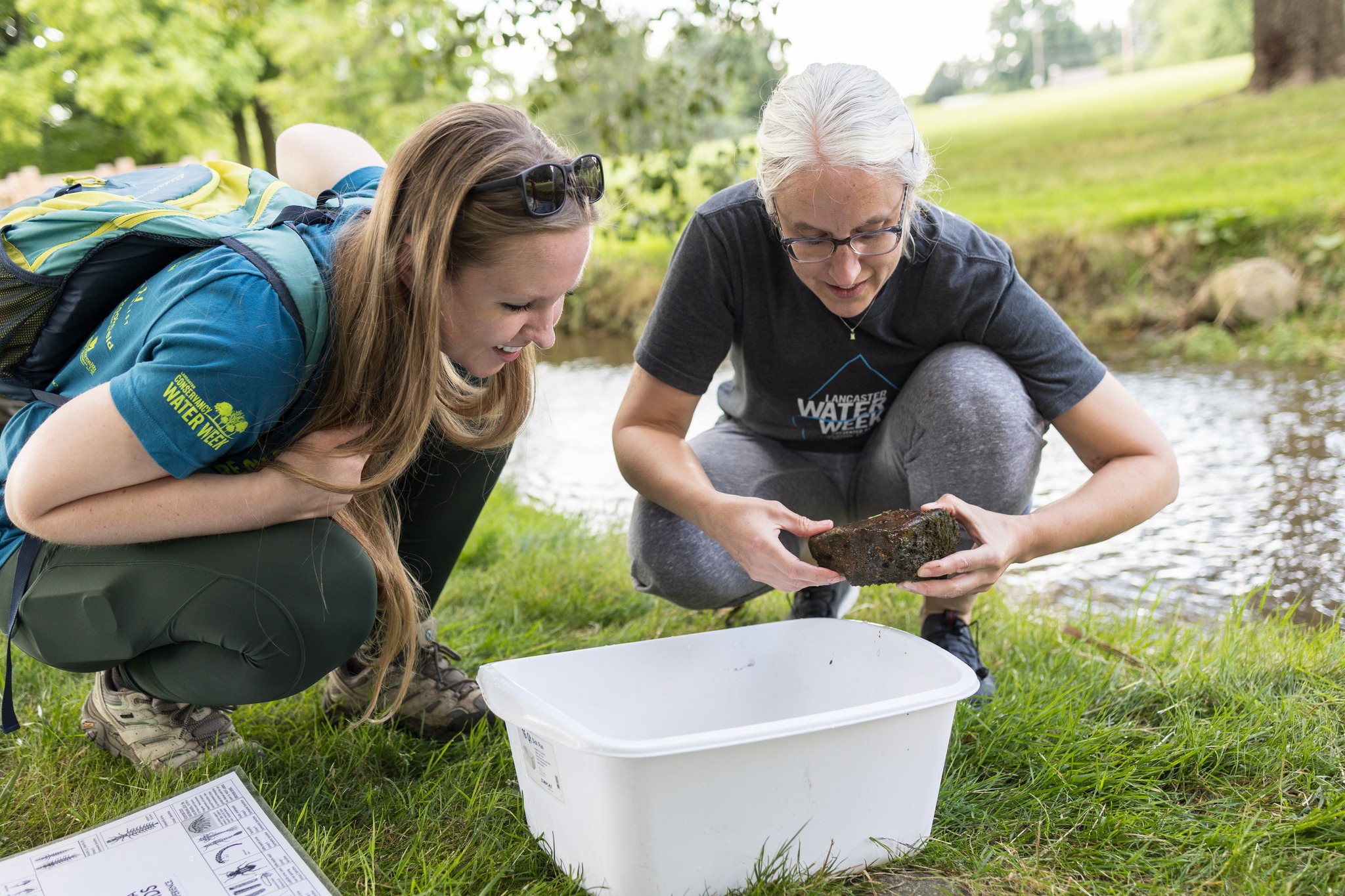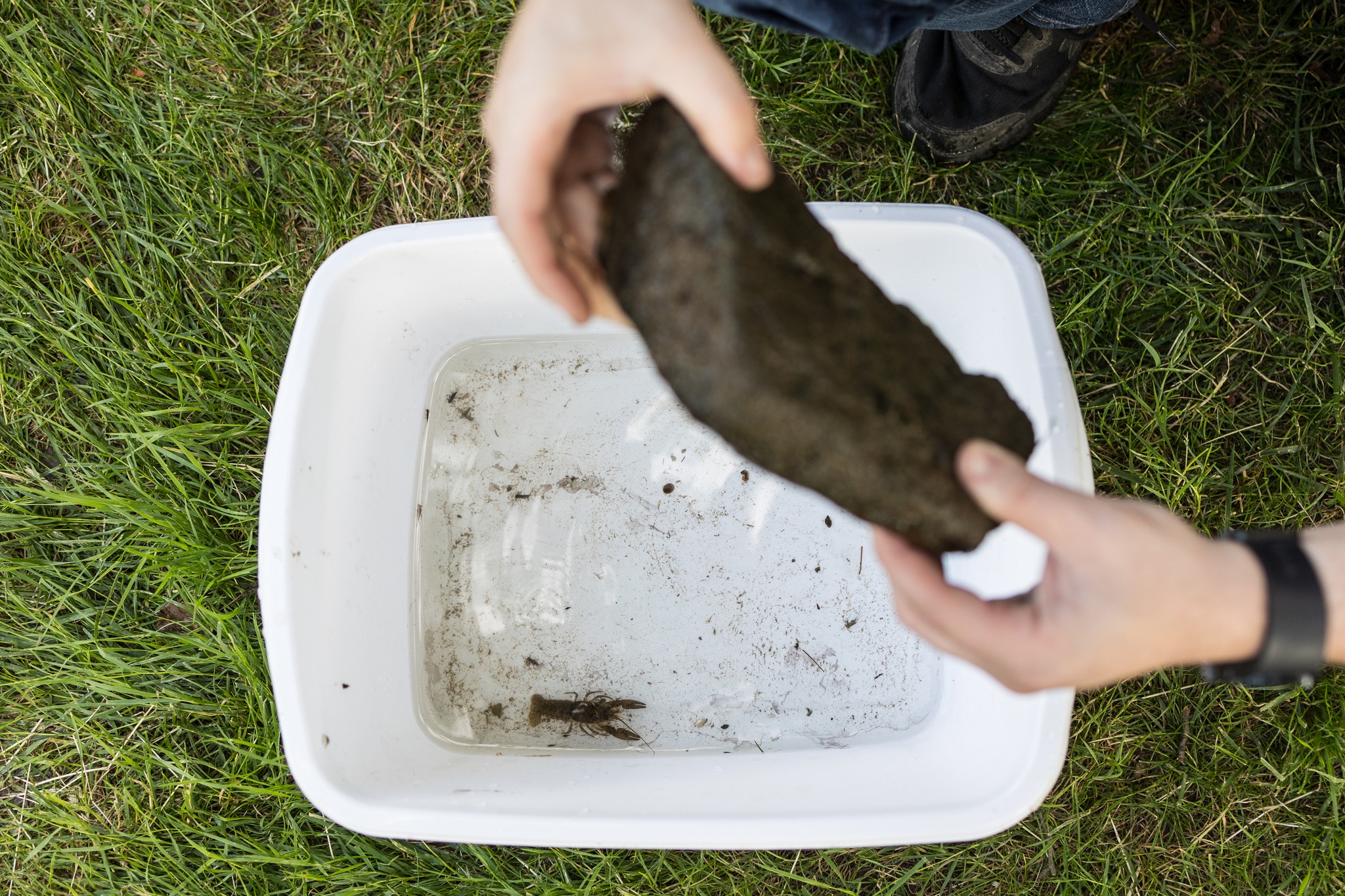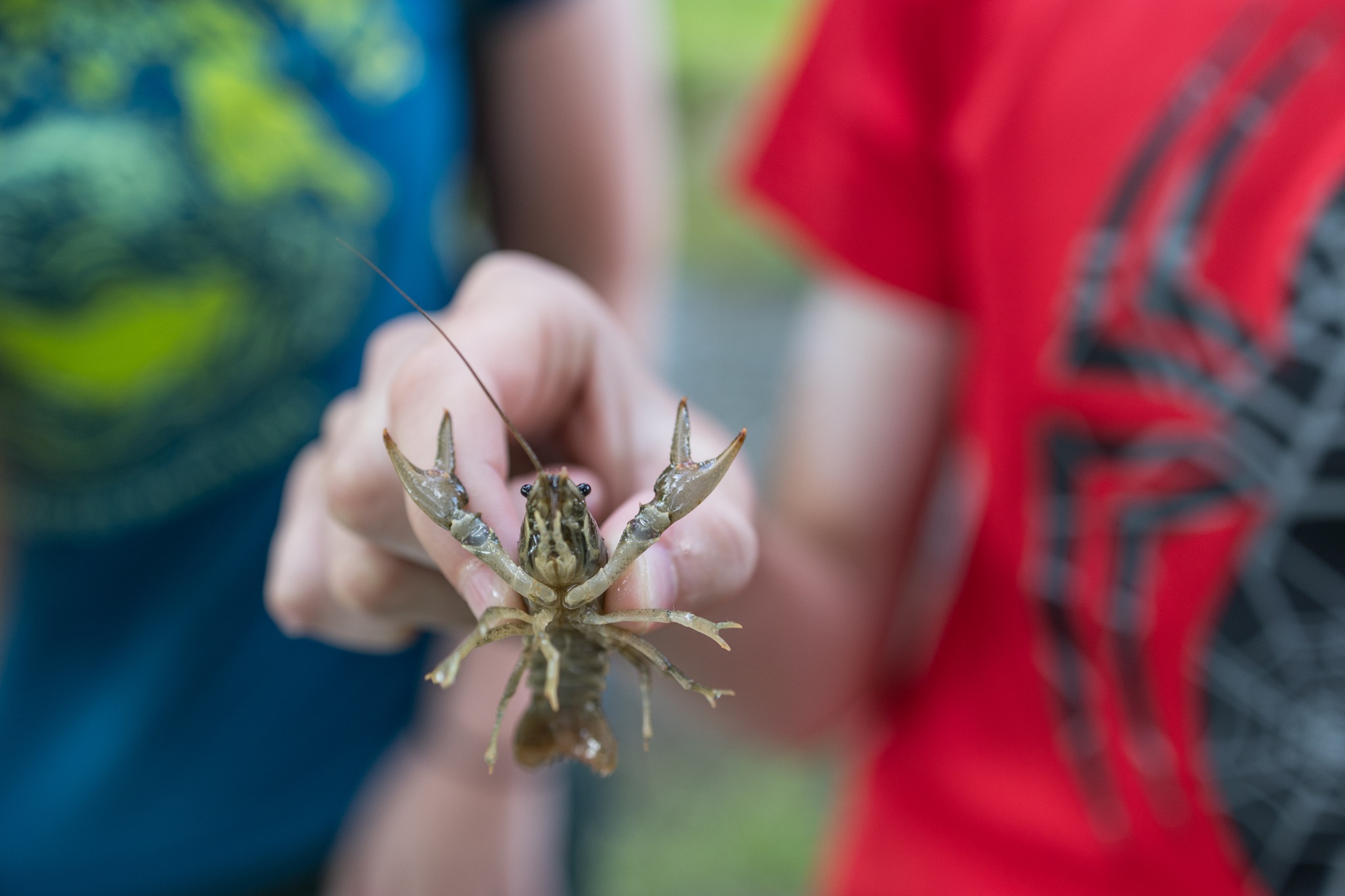By Keith Williams, Vice President of Engagement & Education
The excitement rose out of Stauffer Run almost as soon as people waded in from the lawn edge at Greenfield Business Park. The first flipped rock was the reason. The underside crawled with life. Little black squiggles scurried for cover. Grey ribbons expanded and contracted slowly away. Still others withdrew inside their cases that were securely attached to the rock with fine silken threads. There is a whole aquatic universe hidden amongst the cobbles in Stauffer Run and any other crick, creek, river, or stream.
These are benthic macroinvertebrates, a big word to basically mean the tiny forms of life without backbones who live on the bottom of streams. They are often thought of as river bugs, because many kinds of benthic macroinvertebrates are the aquatic juvenile forms of insects, but the benthic macroinvertebrate group includes a wide variety of life: crayfish, leeches, freshwater clams, mussels, and snails all make up the community that lives on the bottoms of streams and is so ecologically important to our waterways’ health.
The species that compose this community tell us about water quality. They integrate water chemistry over time so that when we find organisms we know are sensitive to poor water quality, we can be certain clean water flows in the stream most of the time, which means the watershed is also healthy.
A watershed is the area of land surrounding a water body that drains into that water body. Forests, grasslands, and wetlands act as water filters, and runoff coming from watersheds dominated by these ecosystems is typically clean, meaning the streams that flow through them are typically healthy. If the watershed is developed into impervious surfaces like driveways, rooftops, and roads, then streams are likely to be impacted. Waterways are impacted by what happens on land, and benthic macroinvertebrates – river bugs – reflect the quality of waterways.
Beyond their utility to us as water quality indicators, benthic macroinvertebrates perform functions that keep stream ecosystems in balance and fuel terrestrial, or land-based, ecosystems as part of a greater food web. Many of the organisms that make up the bottom-dwelling community in the waterway eat detritus – dead plant matter – and then they are eaten by fish and other larger stream-dwelling organisms. Some filter water in order to eat, and then transfer the energy they gleaned from the stream to the terrestrial system when they may be eaten as winged adults. Some species also function as ecosystem engineers.
However, the excitement of these creatures doesn’t come from the functions they perform, but rather just their mere presence. The excitement at Stauffer Run was a celebration of the life in the creek. People were exploring Stauffer Run as part of a program to see what life was there, and the fact that we found so much was exciting in itself.
The little black squiggles that scampered over the rock looking for cover were mayfly nymphs. They are perfectly adapted to cling to rocks in the swiftest currents. Their thin wedge-shaped head allows the forceful water to press them to the rock, and their legs extend to their sides allowing them to scamper about. Their three tails add stability and act as rudders to keep them pointed into the current.
There are 600 species of mayfly in North America, 3,000 worldwide. They occupy three functional feeding groups: predators, collector–gatherers, and scrapers. The collector-gatherers and scrapers convert vegetative matter – leaf matter that falls into streams and makes up 50% of the food budget for creeks – into insect biomass that is then eaten by fish, like trout. Trout do indeed grow on trees thanks to collector-gatherer mayflies who turn leaf litter into fish food. Scrapers graze algae off rocks and turn that vegetative matter into insect biomass. All functional feeding groups of mayflies are food for fish.
What we’ve spotted in Stauffer Run are the juvenile forms of the mayfly, and after a year or two of living as the aquatic nymph (depending on species), they emerge as terrestrial winged adults. They belong to the insect order Ephemeroptera, named because of their short adult life span of a day or two. Their only purpose as an adult is to mate, and the short-lived adults don’t have any mouth parts. No need. When they hatch and fly away, all that stream-derived nutrition fuels terrestrial, land-based, systems as they become food for birds, spiders, lizards, bats, and flying squirrels
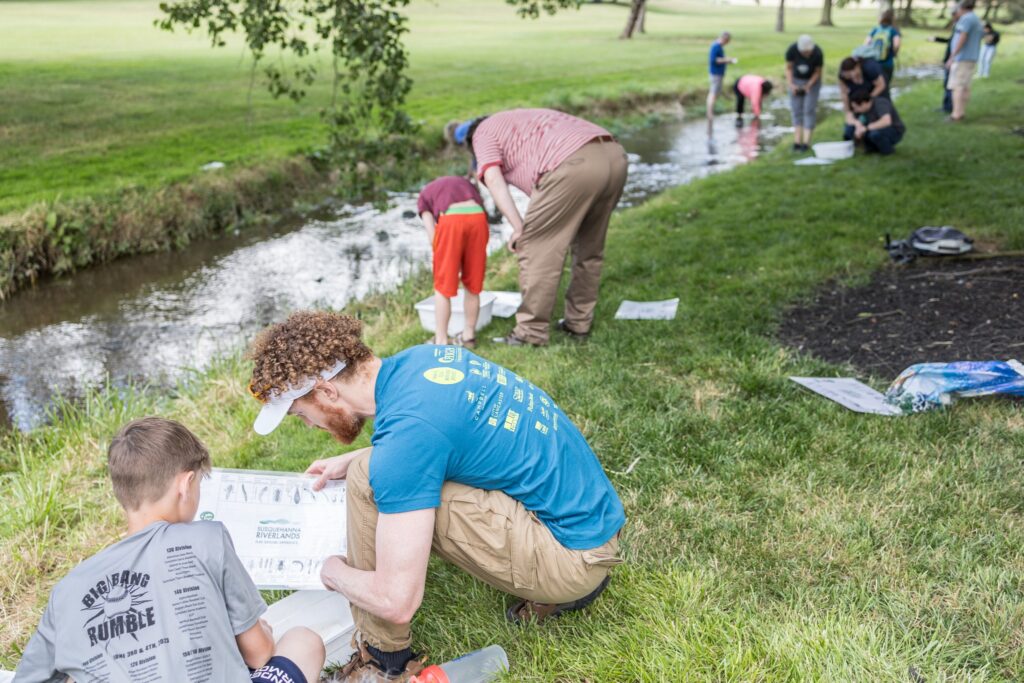
Greenfield stream exploration participants examine the critters they’ve found (Photo by PhotOle Photography)
We were able to pluck a few of the mayflies off the rock – always a challenge since they are able to cling and scamper so tightly in the crevasses – and place them into a container to get a closer look at how amazingly adapted they are for the stream environment.
We also spotted half-inch long sand grain tubes attached to other rocks, and fine-threaded webs strung between cobbles. Both are the work of different kinds of caddisfly larvae. They live aquatically for a year or two depending on species, then emerge as winged adults who live from a few days to a few weeks, again depending on species. There are 1,300 species of caddisfly in North America, 14,000 on Earth.
Caddisflies have silk glands on their lower jaw like those found in moths and butterflies. Some use the silk threads to glue sand grains or pebbles together to use as their larval cases. Some glue twigs and sticks together. Others use leaves, pine needles, or even aquatic vegetation. Regardless, I am always in awe of the beauty in their architecture. Form and function at their finest.
Some species of caddisfly larvae lug their constructed homes around as they graze. Others extend their legs from a home that they firmly attached to a rock, snagging whatever tiny morsels are flowing downstream in the current and licking them off. Others spin webs to capture food particles drifting downriver. Different species spin webs with different mesh sizes so that all the fine organics in the water, along with sediment particles, are filtered out. Whether they graze, lick particles they’ve captured off their legs, or eat them from a web, all caddisfly larvae perform critically important water cleaning functions. Plus, their webs connect stones on the bottom of streams, which helps stabilize them and keep them in place during heavier flows. Caddisflies may be the ultimate stream ecosystem engineers.
We put the mayflies and caddisflies back in the hopes they will metamorphose to the ephemeral winged adults next year. We are losing mayfly, stonefly, and caddisfly species rapidly. In a 2019 paper, Drs. Sanchez-Bayo and Wyckhus estimate 33% of these aquatic species are threatened with extinction. We all have work to do to make sure these species aren’t ephemeral to this planet.
We continued our exploration of Stauffer Run and found other amazing life: juvenile crane flies who resemble Jabba the Hutt and turn into the big commonly called mosquito hawks, though they sip plant juices rather than hunt the biting insects; multiple crayfish, the great stream scavengers; and non-native Corbicula clams who, though not from here, still perform a stream cleaning functions through filter feeding. Taken in total, the life of Stauffer Run told us that this stretch of stream that flowed through the Greenfield campus was healthy.
Each of us lives in a watershed, so each of our daily actions and choices can influence the health of streams and rivers. We can all do our part to protect our waterways and ensure that these river bugs and the interconnected food webs and ecosystems in which they (and we) exist survive and thrive for years to come.
